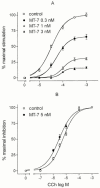Inhibition of acetylcholine muscarinic M(1) receptor function by the M(1)-selective ligand muscarinic toxin 7 (MT-7)
- PMID: 11015294
- PMCID: PMC1572361
- DOI: 10.1038/sj.bjp.0703606
Inhibition of acetylcholine muscarinic M(1) receptor function by the M(1)-selective ligand muscarinic toxin 7 (MT-7)
Abstract
MT-7 (1 - 30 nM), a peptide toxin isolated from the venom of the green mamba Dendroaspis angusticeps and previously found to bind selectively to the muscarinic M(1) receptor, inhibited the acetylcholine (ACh)-stimulated [(35)S]-guanosine-5'-O-(3-thio)triphosphate ([(35)S]-GTPgammaS) binding to membranes of Chinese hamster ovary (CHO) cells stably expressing the cloned human muscarinic M(1) receptor subtype. MT-7 failed to affect the ACh-stimulated [(35)S]-GTPgammaS binding in membranes of CHO cells expressing either the M(2), M(3) or M(4) receptor subtype. In N1E-115 neuroblastoma cells endogenously expressing the M(1) and M(4) receptor subtypes, MT-7 (0.3 - 3.0 nM) inhibited the carbachol (CCh)-stimulated inositol phosphates accumulation, but failed to affect the CCh-induced inhibition of pituitary adenylate cyclase activating polypeptide (PACAP) 38-stimulated cyclic AMP accumulation. In both CHO/M(1) and N1E-115 cells the MT-7 inhibition consisted in a decrease of the maximal agonist effect with minimal changes in the agonist EC(50) value. In CHO/M(1) cell membranes, MT-7 (0.05 - 25 nM) reduced the specific binding of 0.05, 1.0 and 15 nM [(3)H]-N-methylscopolamine ([(3)H]-NMS) in a concentration-dependent manner, but failed to cause a complete displacement of the radioligand. Moreover, MT-7 (3 nM) decreased the dissociation rate of [(3)H]-NMS by about 5 fold. CHO/M(1) cell membranes preincubated with MT-7 (10 nM) and washed by centrifugation and resuspension did not recover control [(3)H]-NMS binding for at least 8 h at 30 degrees C. It is concluded that MT-7 acts as a selective noncompetitive antagonist of the muscarinic M(1) receptors by binding stably to an allosteric site.
Figures





Similar articles
-
Effects of clozapine on rat striatal muscarinic receptors coupled to inhibition of adenylyl cyclase activity and on the human cloned m4 receptor.Br J Pharmacol. 1997 Oct;122(3):401-8. doi: 10.1038/sj.bjp.0701357. Br J Pharmacol. 1997. PMID: 9351494 Free PMC article.
-
Action of the muscarinic toxin MT7 on agonist-bound muscarinic M1 receptors.Eur J Pharmacol. 2004 Mar 8;487(1-3):65-72. doi: 10.1016/j.ejphar.2004.01.029. Eur J Pharmacol. 2004. PMID: 15033377
-
Selectivity profile of muscarinic toxin 3 in functional assays of cloned and native receptors.J Pharmacol Exp Ther. 1999 Jan;288(1):164-70. J Pharmacol Exp Ther. 1999. PMID: 9862767
-
The pharmacological action of MT-7.Life Sci. 2005 Feb 18;76(14):1547-52. doi: 10.1016/j.lfs.2004.10.029. Epub 2004 Dec 18. Life Sci. 2005. PMID: 15680165 Review.
-
m1-toxin.Life Sci. 1993;52(5-6):433-40. doi: 10.1016/0024-3205(93)90299-i. Life Sci. 1993. PMID: 8441325 Review.
Cited by
-
Structure and selectivity engineering of the M1 muscarinic receptor toxin complex.Science. 2020 Jul 10;369(6500):161-167. doi: 10.1126/science.aax2517. Science. 2020. PMID: 32646996 Free PMC article.
-
Identification of a novel snake peptide toxin displaying high affinity and antagonist behaviour for the α2-adrenoceptors.Br J Pharmacol. 2010 Nov;161(6):1361-74. doi: 10.1111/j.1476-5381.2010.00966.x. Br J Pharmacol. 2010. PMID: 20659106 Free PMC article.
-
Effects of muscarinic toxins MT1 and MT2 from green mamba on different muscarinic cholinoceptors.Neurochem Res. 2002 Nov;27(11):1543-54. doi: 10.1023/a:1021660708187. Neurochem Res. 2002. PMID: 12512959
-
Engineering of three-finger fold toxins creates ligands with original pharmacological profiles for muscarinic and adrenergic receptors.PLoS One. 2012;7(6):e39166. doi: 10.1371/journal.pone.0039166. Epub 2012 Jun 14. PLoS One. 2012. PMID: 22720062 Free PMC article.
-
Inhibition of transmitter release from rat sympathetic neurons via presynaptic M(1) muscarinic acetylcholine receptors.Br J Pharmacol. 2009 Apr;156(8):1342-52. doi: 10.1111/j.1476-5381.2009.00136.x. Epub 2009 Mar 20. Br J Pharmacol. 2009. PMID: 19309359 Free PMC article.
References
-
- ADEM A., KARLSSON E. Muscarinic receptor subtype selective toxins. Life Sci. 1997;60:1069–1076. - PubMed
-
- ADEM A., ASBLOM A., JOHANSSON G., MBUGUA P.M., KARLSSON E. Toxins from the venom of the green mamba Dendroaspis angusticeps that inhibit the binding of quinuclidinyl benzilate to muscarinic acetylcholine receptors. Biochim. Biophys. Acta. 1988;968:340–345. - PubMed
-
- BRADFORD M.M. A rapid and sensitive method for the quantitation of microgram quantities of protein utilizing the principle of protein-dye binding. Anal. Biochem. 1976;72:248–254. - PubMed
-
- CARSI J.M., VALENTINE H.H., POTTER L.T. m2-Toxin: A selective ligand for M2 muscarinic receptors. Mol. Pharmacol. 1999;56:933–937. - PubMed
Publication types
MeSH terms
Substances
LinkOut - more resources
Full Text Sources
Molecular Biology Databases

